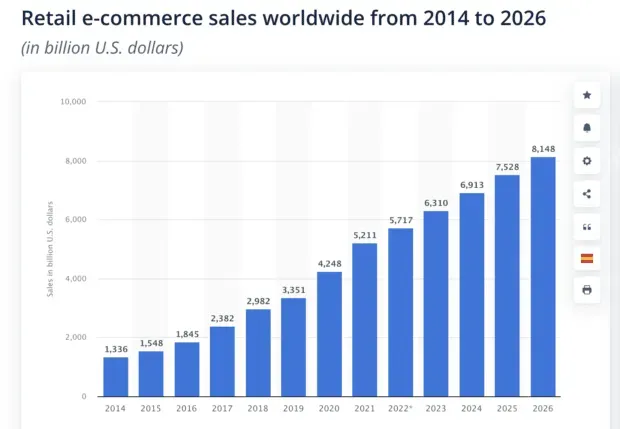The two retail trends that every business can look forward to in 2023 are change and innovation. Online and face-to-face retailing is moving faster than ever. Technological innovation is leading this process. And so consumer expectations are changing.
Businesses need to be aware of retail trends that will impact their success in order to get ahead of the curve. Adopting these changes will help retailers thrive this year and beyond. But we know that it can be difficult to stay on top of trends outside of everything that’s going on for you as a business owner.
That’s why we’ve rounded up the latest retail trends for 2023 and presented them in an easy-to-understand blog post. Keep reading to stay on trend!
Why are retail trends important?
Retail trends are more than just blog posts. They are markers of what companies should be focusing on and investing in.
That’s why you should pay attention to retail trends for 2023.
Communicate your business strategy
Retailers must keep abreast of their industry and market. Tracking retail trends ensures you know what’s important today and tomorrow.
Understanding current and future market forces means you can counter them. Over the past few years, online shopping has exploded. In 2022, 58.4% of internet users worldwide bought something online weekly! And 30.6% of those purchases were made from a mobile device.
The takeaway from this is that if your business doesn’t have a mobile-focused e-commerce store and you don’t sell on social media, then you are already one step behind the rest of the industry.
Stay up to date with retail trends and incorporate them into your business and marketing strategies for 2023 and beyond.
Anticipate customer needs
Customer expectations are changing. How you will attract customers next year will not be the same as last year. And new competitors in your industry are meeting those needs in new, innovative ways.
Retail trends help you stay on top of customer needs, shopping desires and expectations. And they allow you to monitor how your competitors treat them. This allows you to change your strategy to meet new needs as needed.
Get ahead of the curve
Online and offline retail are changing rapidly. New technologies are being introduced all the time to offer:
- Multi-channel shopping
- Self-service trading
- social selling
- Automation
- same day delivery
- Interactive retail experience
- New customer acquisition channels
If you stay up to date with retail trends, especially technology trends, you can stay one step ahead of the competition. It also ensures that you can take advantage of new technologies as they are released.
Stay relevant
Keeping up with new retail trends means staying up to date and up-to-date. There are many stories of retailers who failed to grow with the market. Blockbuster is a good example.
These companies often fail due to the loss of relevance. They lose sight of what their customers want today. As a result, they are losing the customers of tomorrow.
Keeping track of retail trends ensures that your company does not get left behind in its industry. This allows you to adapt to changing customer expectations. And it allows you to reach out to generation after generation of consumers.
By doing so, you stay relevant and thrive as a company.
Take advantage of new opportunities
Retail trends ensure that you can identify and seize new opportunities as they arise.
Tracking retail destinations allows you to:
- Entering new market segments
- Launch of new sales and marketing channels
- Offer new products and services
- Give your customers new opportunities
This requires significant investment. To justify this investment, you need strong market signals. Retail trends are one way to get that signal.
Spotting opportunities early means you’re one step ahead of the competition. This opens the door to expansion and dominance in new market segments or regions.
10 Important Retail Trends for 2023 to Follow
In 2022, consumer voices have been heard loud and clear. And we can expect this to continue into 2023. At the same time, technology is greatly expanding the opportunities for online and offline retail, and business models need to be adapted.
These are the ten most important retail trends to follow.
E-commerce is here to stay
E-commerce popularity and sales have skyrocketed during the COVID-19 pandemic. This growth has slowed down, but e-commerce shopping habits still persist.
Technology has made it easier to sell online and social commerce is on the rise. As a result, there are currently between 12 and 24 million e-commerce stores in the world. And 58.4% of internet users buy online every week.
As a result, analysts expect the global e-commerce industry to grow to $8.1 trillion by 2026. This is up from $5.7 trillion in 2022.

Source: Statistics
E-commerce will continue to grow in both popularity and sophistication in the coming years. In fact, eMarketer predicts that e-commerce websites will account for 22.3% of total retail sales by 2023.
What does this mean for retailers? Now is the time to double and triple your e-commerce commitment. We are fast approaching a state of retail where online shopping is non-negotiable for consumers.
Safety matters to consumers
Governments and consumers are demanding greater protection of personal data and privacy.
Two factors contribute to this:
- Growing concerns about how social networks and websites collect and use data
- Starting in 2020, retail is becoming the most targeted sector for cyberattacks.
To respond to this demand, governments around the world have introduced basic privacy laws such as:
- Chinese Personal Information Protection Law
- Brazilian General Data Protection Law
- California Consumer Privacy Act
- EU General Data Protection Regulation (GDPR)
These laws effectively dictate how companies collect, store, and use user data in the name of online security and privacy.
Consumers also talk about their online safety. And they overwhelmingly said they want to know how retail brands are using their data.
Consumer privacy statistics show that about 81% of Americans express concern about companies that collect personal data.
Forbes recommends the following measures to keep users safe:
- Use of reliable payment systems
- Establishing and Enforcing Best Practices for Data Privacy and Security
- Using Fraud Prevention Tools
- Installing SSL Certificates
- Ensuring your site is fully PCI compliant
- Invest in a quality hosting provider
Consumers have begun to understand why they need to protect their data online. Retailers will have to respond to this demand.
Self-checkout options
The expectation in 2022 is fast and efficient personal shopping. Self-checkouts are the main driver of this demand.
In 2021, the self-service checkout market was valued at $3.44 billion. The annual compound growth rate (CAGR) is expected to be 13.3% between 2022 and 2023.
What is driving this demand? According to Grand View Research, this is a combination of pressure from:
- Increasing the cost of retail store space
- Increasing consumer queue time
- Shortage of workers
- Rising labor costs
- Pursuit of personalized shopping
Retailers are trying to find ways to automate processes and cut costs. Consumers want personalization, efficiency, and the ability to choose their own retail experience.
As a result, 58% of North American retail shoppers surveyed said they had used in-store self-service checkouts. 48.7% say they use it exclusively. 85% think self-service is faster than waiting in line. And 71% would like to have an app with which they can buy groceries instead of waiting in line at the checkout.
Chatbots are the new team members
Chatbots for e-commerce have also grown in popularity in recent years. Gartner predicts that by 2027 they will become the main customer service tool for 25% of companies.
It’s not hard to see why. Chatbots help businesses:
- To save money
- Provide the best customer service
- Engage with customers across multiple channels at scale
- Provide consistent customer service
- Expand worldwide without incurring additional overhead
Retailers can use an e-commerce chatbot like Heyday to:
- Answer frequently asked questions
- Engage the client
- Automate a personalized shopping experience
- Offer support after online sales with shipping and tracking information
- Gather feedback and data
- Provide multilingual support
And they can do all this at any time of the day without getting tired and without having to pay multiple salaries. Chatbots are, in fact, the perfect addition to any retail team looking to provide omnichannel customer support.

Making an appointment at the store
Appointment shopping allows shoppers to reserve time in the store to view products. This is an omnichannel retail strategy based on experience. This provides greater personalization and customer experience.
Consumers can order exclusive in-store purchases through the retailer’s e-commerce website. While there, they are treated as guests and can view and test products using the host. QR codes can be included with products, allowing them to be scanned and purchased later.
Or, if the customer is uncomfortable shopping in a physical store but doesn’t want to deal with shipping and supply chain issues, they make an appointment to buy online and pick up in store.
24/7 customer support
Customer expectations for customer service are higher than ever. Positive and negative experiences can affect the likelihood of a repeat referral.
But customer service doesn’t have to be just good. It must also be always available. This is especially true for global retailers whose customers are located in time zones around the world.
By providing reliable 24/7 customer support, they improve their customer relationships. And, more importantly, they can alleviate frustration caused by issues that are beyond their control.
But it’s not realistic to have a human support team available 24/7, so a chatbot can be handy. An AI conversational chatbot like Heyday can provide 24/7 customer support to answer frequently asked questions in multiple languages.
According to Retail Dive, 93% of respondents in a recent survey said they would be more tolerant of shipping delays if the brand offered great customer service. Now it’s worth noting!
Multi-channel shopping
To remain competitive, retailers must integrate offline stores and online stores.
Multi-channel shopping quickly became the norm. Consumers want to be able to do research online and buy in the store. Or vice versa. And the distinction between them has been blurred in recent years.
- 60% of consumers say they do online research online before making a major purchase.
- In 80% of cases, the consumer returns the product to the store and spends the refund from the same seller.
This means that retailers must provide an integrated online and offline experience, and these two worlds must flow seamlessly into each other.
Transparency in delivery
Delivery speed, cost and transparency are the top three retail trends for 2023.
- According to a recent Forbes survey, 36% of consumers said they would forego ridesharing for a year in exchange for free shipping on all online orders. Another 25% are ready to give up coffee, and 22% would give up Netflix.
But fast and free shipping is not enough. Keeping delivery promises is also critical to attracting and retaining customers.
To do this, retailers need to be transparent about delivery times and delays. When a delivery is delayed but consumers are not informed, 69.7% say they are less likely to buy from that seller again.
To ensure transparency, FedEx recommends:
- Setting clear and realistic expectations for delivery times
- Allowing customers to check delivery status on demand
According to them, “transparent shipping information will be a bet on the table as more consumers demand more control.”
Less waste in packaging
Consumers are demanding that retailers use recyclable and sustainable packaging for their products for both digital and physical purchases. And this is not surprising. E-commerce packaging is the industry’s largest emitter. In fact, it’s six times more than store-bought products.
According to the Shorr Sustainable Packaging Consumer Report:
- 76% of respondents said they made a conscious effort to buy greener products last year.
- 86% say they are more likely to purchase from retailers if the packaging is sustainable.
- 77% expect more brands to offer 100% sustainable packaging in the future.
Consumer demand for sustainable packaging exists. And retailers are paying attention. If sustainability and low-waste packaging aren’t already a priority for you, then it should be in 2023 and beyond.
Supply chain vulnerability and global crises
No retail trends report for 2023 would be complete without looking at the elephants in the room. 2022 has seen significant global shocks that have made life difficult for retailers around the world.
War in Ukraine. Current supply chain and logistics issues. Regional and global economic crises. And changing national trade agreements. All this creates serious obstacles for retailers.
But buyers still expect transparent delivery. And they need sustainable products, fair prices, and solid customer support.
The coming years will require retailers to be flexible and flexible. Find ways to meet these demands through technology, innovation and retail trends.


